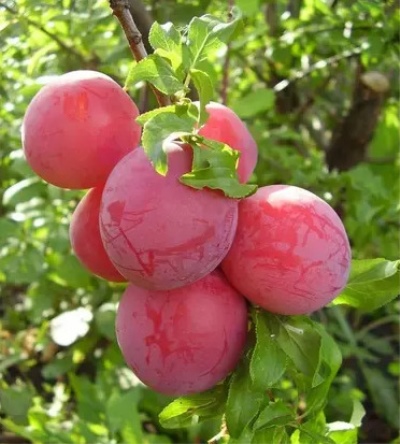
- Authors: folk selection
- Year of approval: 1947
- Growth type: medium-sized
- Crown: 100-shaped (oval-spherical), slightly spreading, of medium density or sparse
- Tree height, m: 3,5
- Fruit size: small
- Fruit weight, g: 15-20
- Fruit shape: rounded oval or ovoid, unequal
- Fruit color: main color is pink-red, integumentary crimson-violet, waxy bloom is bluish
- Skin : thin, with a waxy coating, easily removable, no pubescence, medium density
Red early ripening is a popular variety of plum of home breeding. It is well adapted to the climate and conditions of the middle zone, it tolerates weather and climatic whims well. The purpose of the fruits is universal, but they have no prospects for commercial cultivation due to their low marketability.
Breeding history
The variety was approved for use in 1947. There is no exact information about breeding work. The most likely "parent" is the common Hungarian, which has undergone cross-pollination. It is known that the seedlings were delivered from the place where the famous Regel and Kesselring nursery was located earlier. It has been included in the VIR collection since 1926.
Description of the variety
Plants form in the form of a tree on a trunk or several trunks. The variety is medium-sized, reaching up to 3.5 m in height. The crown is hundred-shaped, close to an oval or ball, lush, slightly spreading. The density is medium or sparse. Skeletal branches are strong, strong, branch off from the trunk at an angle of no more than 50 degrees.
Shoots are greenish-brown, slightly curved, glabrous. Leaves are slightly pubescent along the bottom of the plate. The top is smooth, with a noticeable glossy sheen, painted green. The flowers are goblet or cupped, painted pink. The life span of this tree can reach 20-25 years.
Fruit characteristics
The plums of the Skorospelka variety have small red fruits with a thin skin with a noticeable waxy bloom. The pulp is yellow inside, it oxidizes rather quickly in air. The color of the fruits themselves is complex, pink-red at the base with a bright raspberry-purple cover. Wax deposits can cause the surface of the plums to appear bluish. The seeds have good separability from the pulp.
Taste qualities
Plums are sour-sweet, pleasant, refreshing, with a light aroma. They are stored after collection for no more than 25 days, they are quickly put into processing. The pulp is slightly dry, slightly sugary, with fine fibers.
Ripening and fruiting
The early maturity of a variety largely depends on how it is planted. For example, grafted plums give their first harvest in 3-4 years of planting. In terms of ripening, Skorospelka red belongs to the early varieties. Fruiting annually, without skipping, in the 2nd half of August or early September.

Yield
In season, from an adult plum, you can collect 25-40 kg of ripe fruits.
Growing regions
The plum variety Skorospelka red is zoned for cultivation in the climatic zone of the northwest.It is also successfully cultivated in the Central Black Earth Region, on the Middle Volga.
Self-fertility and the need for pollinators
The trees are partially self-fertile. When growing 1 tree in the garden, it will take a long time to wait for the harvest. It is pollinated by such varieties of plums as Renklode reform and collective farm, Hungarian Moscow, and others, with the same flowering dates, from about the 2nd decade of May.
Growing and care
The variety needs to be planted on light soils, protected from waterlogging. The representatives of this variety feel good on the hills, bathed in the sun. This plum is planted only in the spring, with placement in areas protected from the through wind. The soil under the seedling is dug up, freed from weeds, loosened, fertilized. Subsequent feeding will be needed after 3 years.
The branches of a young plum are immediately pruned, thinned out. Inflorescences are cut off completely for 1 year. Throughout the summer, trees will need a weekly watering of 10 liters of water.




Disease and pest resistance
The variety is moderately susceptible to the development of diseases and pests. It is strongly affected by clasterosporium disease. Needs preventive treatments for aphids.

Despite the fact that plum is considered more hardy than many fruit trees, it is not immune from diseases. It is attacked by viral, fungal and bacterial infections, and parasitic insects harm it. It is necessary to notice and recognize the signs of plum disease in time. They are easier to deal with and defeat early on. Well, in order to protect the garden tree from such a misfortune in the future, preventive procedures can be carried out.

Review overview
According to summer residents, Skorospelka red has a lot of advantages. It is winter-hardy, it is also not afraid of drought, it easily takes root on a variety of soils. With its unpretentiousness, this plum literally won the people's love. Many gardeners mention that even out of season the tree looks very decorative due to the correct shape of the crown. Early maturity is also a big advantage; it will not take long to wait for the first harvest after planting.
The main breeding method for this variety is the active formation of root shoots. This greatly facilitates the work of summer residents when obtaining material for updating the garden.
The disadvantages of this variety are also quite easily detected by gardeners. For example, not everyone is happy with the small size of the fruit and the too dense fibrous pulp. And also a big drawback of this plum is the tendency to discard fruits with poor watering or delay in harvesting. The owners are not too happy with the fact that products of low commercial quality appear on the tree. Even such fruits are not allowed to be processed.


































































